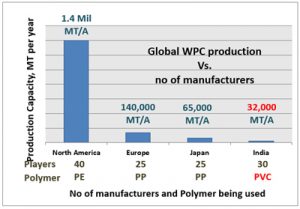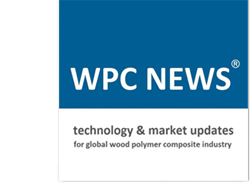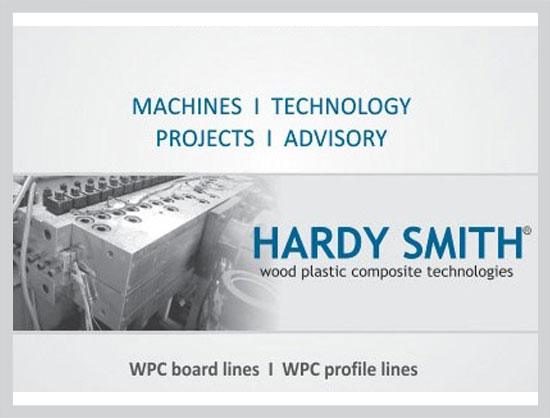WOODNEWS Magazine, July, 2013, India.
Q1: Why are you promoting wood-polymer composite (WPC) when wood is nowadays so freely imported from professionally managed and certified suppliers abroad?
A1: Wood plastic composite manufacturing doesn’t need logs or timbers, but this subject is a boon for wood wastes including sawmill dust, plywood sanding dust, bagasse dust, Rice husk, Jute husk and other forms of wood wastes. WPC product formation can use such natural fibre wastes ranging from 10% to 70% of formulation. Thus directly it has no relation with forests and bigger formats of wood and timbers. This way we are saving forests at the first sight and utilizing waste materials at a great instance.
India is being developed as a prominent manufacturing destination for WPC products, globally. Started reversely from international WPC trends India has picked up WPVC panels, rapidly due to all time favourite and upcoming infrastructure developments within the country. India has ‘yet to see’ situation for furniture industry.
The entire agenda of developing the WPC market is to give a life time and quality product for Indian homes, offices, hotels, hospitals and schools. WPC in general can withstand spontaneously against moisture and termite because of its polymeric structure. Today major population of India- taking from slum area to posh villas- are suffering from termite attacks and moisture problems. Natural wood cannot be afforded by 88% of population today. Recent trend in building material and furniture industries is going quite positive with newer materials. Mindset of today’s generation is open, exhaustive and well oriented towards qualitative, innovative, clean & green and value for money products. WPC fits best to their requirements.
Q2: How does WPC really compare with natural wood in terms of strength, durability, workability and sustainability?
A2: Please find the following properties of WPC boards made with PVC as the core polymer.
WPC boards are ideal for panel applications in modular furniture. They can withhold screw well. It has dimensional stability. Moisture and termite resistance gives long lasting durability. Surface is printable. You can apply HPL, Veneer and PVC foils. You can perform carpentry jobs just as like as the natural wood and wood panel. It has good machinability on any panel processing machine. Its polymeric structure with PVC makes WPC 100% recyclable and green material. WPC for India-in indoor applications-is the best material than any other wood panel.
| Sr. No. | Test | Test Method | Value |
| 1 | Density, Kg/m3 | IS: 1734 | 500 – 700 |
| 2 | Water Absorption, 2 hours, % | IS: 2380 | < 0.2 |
| 3 | Water Absorption, 24 hours, % | IS: 2380 | < 1 |
| 4 | Hardness, Shore D | ASTM D 2240 | > 55 |
| 5 | Tensile Strength, N/mm2 | IS: 1734 | > 11 |
| 6 | Elongation at Break, % | IS: 1734 | > 10 |
| 7 | Screw Withdrawal Strength, N | IS: 1734 | > 1500 |
| 8 | Nail Withdrawal Strength, N | IS: 1734 | > 150 |
Courtesy: Plamadera composites, Ahmedabad.
WPC decking or WPC lumber against softwood
| Properties of comparison | WPC – Smart wood | Plantation timbers like eucalyptus/ poplar |
| Sturdier core |  |
 |
| Recyclable material |  |
 |
| Stronger impact resistance |  |
 |
| Low water absorption |  |
 |
| Mould resistance |  |
 |
| Stain resistance |  |
 |
| Rot and splinter free |  |
 |
| Easy to cut, router and fasten |  |
 |
| Easier installation |  |
 |
| High insulation properties |  |
 |
| Aesthetic value |  |
 |
| Ready to use |  |
 |
| Termite and borer resistance |  |
 |
| Easier to clean |  |
 |
| Easier lamination |  |
 |
| Good printing |  |
 |
Courtesy: Libero world, Ahmedabad
Q3: Doesn’t the polymer content in WPC make it less “green” than natural wood?
A3: Green means the product that ‘saves nature – saves natural resources – reduces carbon foot prints – keeps environment clean – uses recycle – can be recycled – has no emission – has no process discharge’.
1. WPC saves trees by not using natural wood from forests – thus it is green.
2. WPC uses the waste wood, wood dust, plywood sanding dust, agriculture waste, and plastic waste – thus it is green as it recycles the natural resources.
3. WPC finished material itself is 100% recyclable and can be reused within the process. WPC products can be recycled anytime during its life cycle – thus is it green.
4. WPC doesn’t emit any gases as a finished product and it is E0 product – thus it is green.
5. Processing of WPC doesn’t create any process waste, waste water or chemical waste – thus it is green.
6. Natural wood, once it is caught up by termite cannot be used again in normal cases. WPC is free from borer and termite – Thus it is green.
7. WPVC like material which is self extinguishing in nature, safe, clean and hygienic-medical grade product – can give a safe and clean life to small children in schools to the employees working in close room conditions. Thus it is green.
All above parameters make WPC more “green” than natural wood.
Q4: How reliable is the formulation of WPC, given that polymers and wood and organic waste do not easily blend or adhere together?
A4: WPC is the better material which can use more agriculture waste with polymers. Conventional wood panels cannot use more agriculture waste those have less fibre value and thus bagasse has been the only successful but saturated option today for particle board and MDF board making. Against WPC can use rice husk, wheat straw, just straw, bagasse, coconut powder, bamboo powder etc with more or equal ratio with polymers.
For any polymer formulations there are additives and fillers required and being used globally. Such fillers and additives are used for property enhancement, property achievement and cost reduction purposes. Polymer is a subject where many new experiments can be carried out with use of such additives. Various properties like density, fire retardancy, UV resistance, colouring, bending, heat stability etc can be adjusted with such additives. Finally fillers including mineral and natural fibre can be used effectively within the cell structure to form a WPC polymer chain.
Q5: What happens when WPC products are rendered useless (breakage, damage in fire, etc.)? Can WPC be recycled? Or will it add to the plastic burden the Earth is already bearing?
A5: WPC is a 100% recyclable product. WPC has a dedicated approach towards wood and allied product replacement, thus it is being used in interior or exterior applications. Country like India has derived WPC as more into interior applications than exterior as of now. WPC is not the commodity plastic but this is a speciality composite known as ‘natural fibre polymer composite’, globally. It has the best uses in furniture industry taking from partitions to modular kitchens. Life of WPC as a product is – far far better than conventional MDF boards, particle boards and plywood – when it comes to moisture, termite and high water conditions in India. Next to its life, WPC can be recycled any time during its life period thus it saves the mother earth from ‘tension of de-forestation’ as well as ‘pressure of re-forestation’.
Q6: How well has WPC caught on globally and in India, in terms of production and business turnover?
WPC has got very well acceptance in recent years in India especially in western, northern and southern parts of India. As a reverse phenomenon WPC is derived more as a panel product – for interiors – with PVC as base material. World market has got more WPC for decking in exterior applications. This phenomenon has taken place naturally because of upraising activities in infrastructure and increasing demands of panel products for partitions, furniture, doors and windows.
Within a time span of 2 years, India has become a hub for WPC boards– next to china and becoming equal to china – globally. More than 30 odd players have installed WPC board lines with manufacturing capacity of 10 cubic meters per day, each. In compare to the size of Indian market it equals to the moderate capacity ‘3’ particle or MDF board line of 100 cubic meters per day. This is a massive acceptance of product and today India started receiving export inquiries from developed countries like USA, Europe, Middle East, Africa, and Australia.

Q7: Why does India stand out in acceptance of WPC? Is it because of greater awareness of choice? Or is it a case of lower pricing?
A7: As mentioned above, acceptance of WPC is at par to the developed countries. Many new players are being added as manufacturer, dealer, distributor, furniture OEM. In terms of awareness WPC still needs more volume of production. Still product is not reached to each and every corner of India. Architects and interior designers are still not much aware with the product and its decency. Carpenters are still unknown to the product otherwise this is the best product to work with. Many players have started their demonstration centres and exclusive dealers. Education conferences and seminars are also initiated by players like Alstone and Ocean. Better event and media participations are also coming up by many players now.
WPC is a classic product when it comes to the case of pricing. It stands moderately with marine ply directly. It stands perfectly with MDF with HPL and even PB with HPL. UV coated WPVC leaves PU coated panels far behind in prices. Printed and Hot transfer laminated WPC boards are about to be launched soon which shall replace ‘Panel with HPL’ application at a high level in wardrobes, kitchens, offices, doors and other panel furniture.
Q8: Apart from consultancy, you also manufacture WPC-based products. With reference to doors and windows, what has been the turnover year-on-year, over the past 5 years?
A8: We are a technology player and we are not into finished product business. We provide plant, machinery, formulations, installation and manpower for WPC Industry in India and globally. We are establishing a workshop for machine assembling and spares. We are coming up with specialty raw material making facility for WPC industry, soon. We are also planning for operator’s training school at Ahmedabad to supply quality manpower to the industry. WPC industry, as I said has evolved within less than 2 years only so it is hard to provide any record for 5 years with reference to doors and windows. But against UPVC windows industry in last 10 years, WPVC industry’s turnover has reached to around 80 Million USD (500 crore INR) including WPC boards, profiles and WPC decking.
Q9: Who are your biggest (retail, corporate) clients? What/where does the big potential in India lie?
A9: All our clients are from wood and furniture background, except 2 clients from Plastic industry. During last two years we have installed lines for Duraplast (board line), Plamadera composites (board line & flooring line), Lirco composites (board line), Ecoste (board line), Pratham WPC (board line under installation) and I-green fibrex (board line). We are in talks with several corporate clients as of now.
In terms of rank in South India comes first considering the weather situation. Next to that Western part has enough potential followed by northern India. East India has equal potential like south because of its developmental scope.

